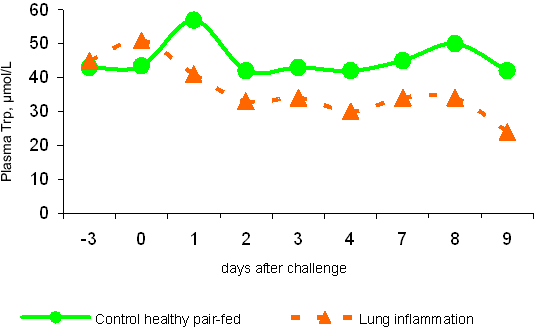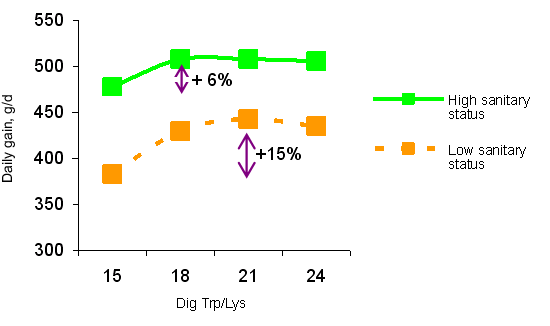Tryptophan has the particularity to be involved in several biological functions such as appetite regulation, stress and immune responses (see the review of Le Floc’h and Sève, Livestock Science, 2007). This explains why the young pigs exhibiting a high growth rate potential are especially sensitive to low and inadequate tryptophan dietary supply. Consequently, requirement and practical recommendations can be different according to the biological function to be optimized. In young pigs, the main effect of tryptophan on growth rate is associated to an increase in feed intake when tryptophan is supplied to a level close to recommendations for a maximum growth rate. However, some factors also impact directly on tryptophan metabolism and thus limit its availability for growth and any other functions in which tryptophan is involved. For example, we will present what can be the impact of a low grade inflammation, such as occurring when pigs are housed in bad sanitary conditions, on tryptophan metabolism and requirement.
Tryptophan metabolism is modified in pigs suffering from inflammation
In pigs, experimental inflammation was associated to a decrease in plasma tryptophan concentrations compared to healthy piglets fed the same amount of feed (Figure 1). Such difference can be explained by difference in tryptophan metabolism leading to tryptophan disappearance from the plasma pool. One explanation is an increase in tryptophan catabolism after activation of one enzyme called IDO or indoleamine 2,3 dioxygenase in pigs suffering from inflammation. Indeed, in rodents and other animal laboratory species, the depletion of free plasma tryptophan has been associated to increased tryptophan degradation under IDO activation occurring in various inflammatory states. Indeed, the enzyme IDO is stimulated by pro-inflammatory cytokines and especially by interferon-γ. This enzyme is present and active in immune cells and in tissues targeted by inflammation. A second cause for low plasma tryptophan concentration corresponds to the incorporation of tryptophan in acute phase proteins synthesized during inflammatory response since these proteins have a high tryptophan content compared to muscle protein. The induction of IDO pathway has been proposed to be a mechanism that limits the availability of tryptophan during an inflammatory process and may play crucial roles in the regulation of the immune and inflammatory responses.

Figure 1. Plasma tryptophan in response to inflammation in piglets
The sanitary status is a factor affecting the growth response to tryptophan
The consequences of the inflammatory and immune responses on tryptophan metabolism could impair the availability of tryptophan for body protein accretion, growth and all other metabolic processes involving this amino acid. In that way, the deterioration of sanitary housing environment after weaning induced a moderate inflammatory response and modifies tryptophan metabolism in piglets. These responses were characterized by reduced growth rate, higher plasma haptoglobin and lower plasma tryptophan concentrations compared to control piglets kept in good sanitary conditions from 8 to 30 kg. Reduced growth rate was still observed when pigs were submitted to a feed restriction in order to compare the effects of sanitary status on growth rate when feed intake was at the same level. Therefore the difference in growth rate between sanitary statuses can be attributed to modifications of nutrient metabolism. Concerning the response of plasma tryptophan, we showed that pigs kept in poor sanitary conditions displayed lower plasma tryptophan concentrations than control piglets whatever the level of dietary tryptophan. Moreover, increased dietary tryptophan did not fully prevent the consequences of sanitary status deterioration on performance. Nevertheless, the growth rate of piglets kept in poor sanitary conditions was more sensitive to low dietary tryptophan than that of control pigs. As a consequence, the improvement of growth rate induced by increased dietary digestible tryptophan content from 15% to 21% of digestible lysine is more important for pigs submitted to a moderate inflammatory challenge caused by poor sanitary conditions (Figure 2). This confirmed that the quality of the environment is a factor affecting the tryptophan requirement.

Figure 2. Growth rate of piglets (from 8 to 30 kg) housed in good or bad sanitary conditions and fed graded levels of tryptophan.





